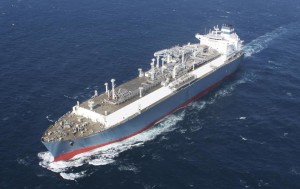ALTERED HABITATS
The fight over liquefied natural gas
AP PHOTO/HOEGH LNG
Hoegh LNG’s gas vessel “Independence” during its sea trial in January.
The fight over liquefied natural gas for so many years was where and how to bring it into the United States. Now the fight is over where and whether to ship it out.
Boston was at the epicenter of the earlier skirmishes. The Everett LNG terminal is the only one that unloads the highly explosive fuel in the middle of a major US metropolitan area. Former Boston mayor Thomas M. Menino became afraid of the potential for catastrophe after 9/11, especially when he learned tanker ships of the stuff were coming from Yemen. But for decades, Everett received about half of the LNG imported to the United States.
Now, with the excess of natural gas created in this country by hydraulic fracturing, gas companies are abuzz with proposals to build terminals to export LNG. And, ironically, New England finds itself watching the debate from the sidelines.
“The shale gas boom has started a race to develop LNG export terminals in North America,” writes industry analyst Daniel Choi in a recent report by Boston-based Lux Research. The report concluded there is $120 billion in proposed LNG export projects. The Federal Energy Regulatory Commission lists 14 current proposals for export terminals.
LNG is tricky stuff. It is natural gas — mostly methane — that is pressurized and super-cooled into liquid to squeeze it into tankers and trucks that go where gas pipelines cannot.
If the stuff leaks out, it vaporizes immediately, and a spark could create a vast fireball that makes emergency officials shudder. They can’t even train for an event that big. A simple tank leak in Cleveland in 1944 incinerated 70 homes and killed 128.
After the Everett facility opened in 1971, 10 other LNG import terminals were approved on the US coastlines — including two other Massachusetts sites: the Northeast Gateway in Massachusetts Bay, 18 miles east of Boston, and the Neptune Terminal, 10 miles off the coast of Gloucester. Those two are basically pipe connections through which ships can pump LNG ashore, where it is turned back into gas and shipped out in pipelines.
But the United States is squeezing natural gas out of shale rocks at a furious pace, and now has a glut of it. The Neptune and Northeast Gateway terminals are not being used; LNG shipments into Everett are way down. Asia, Europe and other markets pay a lot more for natural gas than US customers, so gas companies are chomping at the bit to freeze and ship out fracked gas through export terminals.
“The pendulum has swung the other way,” said Seth Kaplan, vice president of the Conservation Law Foundation in Boston.
Some of the proposed export facilities — such as Cove Point, Md. — would be converted from import terminals. “A lot of the equipment you need is similar. The challenge is the regulatory process,” analyst Choi said in a telephone interview.
But that will not happen in Massachusetts, despite the idle import terminals here, said Kaplan. The main limitation is pipeline capacity. Energy regulators say New England does not have enough pipelines to bring in as much natural gas as it needs, much less pass it through to an export terminal. New England power plants stockpiled — and burned — oil last winter to make sure electric generators kept running when gas supplies ran short.
There also is little economic advantage to passing gas through the region, as Boston pays among the highest rates in the nation for natural gas.
The pipeline giant Kinder-Morgan Energy has proposed a large new pipeline to bring more natural gas into New England from furious fracking going on in the Marcellus shale fields of Pennsylvania.
Kaplan’s group, a nonprofit watchdog of energy matters, opposes that. The existing pipelines in New England could be operated more efficiently to move more gas, Kaplan argues. And the Conservation Law Foundation says shortfalls in New England winters could be made up by importing more LNG, an unusual stance among environmental groups that typically oppose expanding LNG trade.
Mostly, though, Kaplan argues that we should not be building a pipeline that could last 50 to 100 years, when we should be moving off all fossil fuels.
“We need gas in the short term to replace the coal plants and keep the lights on,” he said. “However, when you look at what science tells us needs to be done on climate … Somewhere around 2050 we need to be seriously off of gas and fossil fuels. We need to be pretty much at zero emissions.
“The economics are real, and we recognize them,” Kaplan said. “But at the end of the day, we have this very serious problem that in the longer term, we simply need to make the transition off of gas.”
Doug Struck has been a journalist for 35 years and reports on environmental matters from Boston. He can be reached at doug@dougstruck.com
